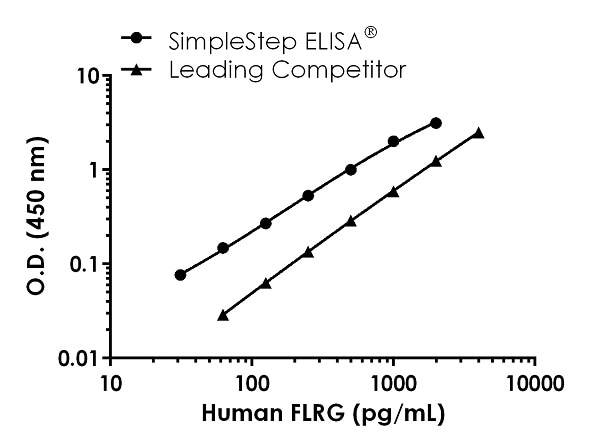Human FLRG ELISA Kit (ab245715)
Key features and details
- One-wash 90 minute protocol
- Sensitivity: 8.2 pg/ml
- Range: 31.25 pg/ml - 2000 pg/ml
- Sample type: Cell culture supernatant, EDTA Plasma, Hep Plasma, Milk, Serum, Urine
- Detection method: Colorimetric
- Assay type: Sandwich (quantitative)
- Reacts with: Human
Overview
-
Product name
Human FLRG ELISA Kit
See all FSTL3 kits -
Detection method
Colorimetric -
Precision
Intra-assay Sample n Mean SD CV% serum 8 4.7% Inter-assay Sample n Mean SD CV% serum 3 6.4% -
Sample type
Cell culture supernatant, Milk, Urine, Serum, Hep Plasma, EDTA Plasma -
Assay type
Sandwich (quantitative) -
Sensitivity
8.2 pg/ml -
Range
31.25 pg/ml - 2000 pg/ml -
Recovery
Sample specific recovery Sample type Average % Range Cell culture supernatant 107 104% - 111% Milk 103 98% - 109% Urine 98 94% - 109% Serum 106 105% - 109% Hep Plasma 101 99% - 105% EDTA Plasma 104 102% - 106% -
Assay time
1h 30m -
Assay duration
One step assay -
Species reactivity
Reacts with: Human
Does not react with: Cow -
Product overview
Human FLRG ELISA Kit (ab245715) is a single-wash 90 min sandwich ELISA designed for the quantitative measurement of FLRG protein in edta plasma, hep plasma, milk, serum, urine, and cell culture supernatant. It uses our proprietary SimpleStep ELISA® technology. Quantitate Human FLRG with 8.2 pg/ml sensitivity.
SimpleStep ELISA® technology employs capture antibodies conjugated to an affinity tag that is recognized by the monoclonal antibody used to coat our SimpleStep ELISA® plates. This approach to sandwich ELISA allows the formation of the antibody-analyte sandwich complex in a single step, significantly reducing assay time. See the SimpleStep ELISA® protocol summary in the image section for further details. Our SimpleStep ELISA® technology provides several benefits:
- Single-wash protocol reduces assay time to 90 minutes or less
- High sensitivity, specificity and reproducibility from superior antibodies
- Fully validated in biological samples
- 96-wells plate breakable into 12 x 8 wells stripsA 384-well SimpleStep ELISA® microplate (ab203359) is available to use as an alternative to the 96-well microplate provided with SimpleStep ELISA® kits.
-
Platform
Pre-coated microplate (12 x 8 well strips)
Properties
-
Storage instructions
Store at +4°C. Please refer to protocols. -
Components 1 x 96 tests 10X Human FLRG Capture Antibody 1 x 600µl 10X Human FLRG Detector Antibody 1 x 600µl 10X Wash Buffer PT (ab206977) 1 x 20ml Antibody Diluent 5BI 1 x 6ml Human FLRG Lyophilized Recombinant Protein 2 vials Plate Seals 1 unit Sample Diluent NS (ab193972) 1 x 50ml SimpleStep Pre-Coated 96-Well Microplate (ab206978) 1 unit Stop Solution 1 x 12ml TMB Development Solution 1 x 12ml -
Research areas
-
Function
Isoform 1 or the secreted form is a binding and antagonizing protein for members of the TGF-beta family, such us activin, BMP2 and MSTN. Inhibits activin A-, activin B-, BMP2- and MSDT-induced cellular signaling; more effective on activin A than on activin B. Involved in bone formation; inhibits osteoclast differentiationc. Involved in hematopoiesis; involved in differentiation of hemopoietic progenitor cells, increases hematopoietic cell adhesion to fibronectin and seems to contribute to the adhesion of hematopoietic precursor cells to the bone marrow stroma. Isoform 2 or the nuclear form is probably involved in transcriptional regulation via interaction with MLLT10. -
Tissue specificity
Expressed in a wide range of tissues. -
Involvement in disease
Note=A chromosomal aberration involving FSTL3 is found in a case of B-cell chronic lymphocytic leukemia. Translocation t(11;19)(q13;p13) with CCDN1. -
Sequence similarities
Contains 2 follistatin-like domains.
Contains 2 Kazal-like domains.
Contains 1 TB (TGF-beta binding) domain. -
Cellular localization
Secreted and Nucleus. Although alternative initiation has been demonstrated and resulted in different localization, the major source of nuclear FSTL3 appears not to depend on translation initiation at Met-27 according to. - Information by UniProt
-
Alternative names
- FLRG
- follistatin-like 3
- follistatin-like 3 glycoprotein
see all -
Database links
- Entrez Gene: 10272 Human
- SwissProt: O95633 Human
- Unigene: 529038 Human
Images
-
SimpleStep ELISA technology allows the formation of the antibody-antigen complex in one single step, reducing assay time to 90 minutes. Add samples or standards and antibody mix to wells all at once, incubate, wash, and add your final substrate. See protocol for a detailed step-by-step guide.
-
Standard Curve comparison between human FLRG SimpleStep ELISA kit and traditional ELISA kit from leading competitor. SimpleStep ELISA kit shows increased sensitivity.
-
The FLRG standard curve was prepared as described in Section 10. Raw data values are shown in the table. Background-subtracted data values (mean +/- SD) are graphed.
-
The concentrations of FLRG were measured in duplicates, interpolated from the FLRG standard curves and corrected for sample dilution. Undiluted samples are as follows: serum 15%, plasma (EDTA) 15%, and plasma (heparin) 15%. The interpolated dilution factor corrected values are plotted (mean +/- SD, n=2). The mean FLRG concentration was determined to be 8,804 pg/mL in serum, 8,996 pg/mL in plasma (EDTA) and 9,092 pg/mL in plasma (heparin).
-
The concentrations of FLRG were measured in duplicates, interpolated from the FLRG standard curves and corrected for sample dilution. Undiluted samples are as follows: milk 15% and urine 15%. The interpolated dilution factor corrected values are plotted (mean +/- SD, n=2). The mean FLRG concentration was determined to be 3,167 pg/mL in milk and 6,392 pg/mL in urine.
-
The concentrations of FLRG were measured in duplicates, interpolated from the FLRG standard curves and corrected for sample dilution. Undiluted samples are as follows: JAR cell supernatants 1%. The interpolated dilution factor corrected values are plotted (mean +/- SD, n=2). The mean FLRG concentration was determined to be 83,631 pg/mL in JAR cell supernatant.
-
Interpolated dilution factor corrected values are plotted (mean +/- SD, n=2). The mean FLRG concentration was determined to be 15,897 pg/mL with a range of 13,362 - 21,062 pg/mL.
-
To learn more about the advantages of recombinant antibodies see here.



















